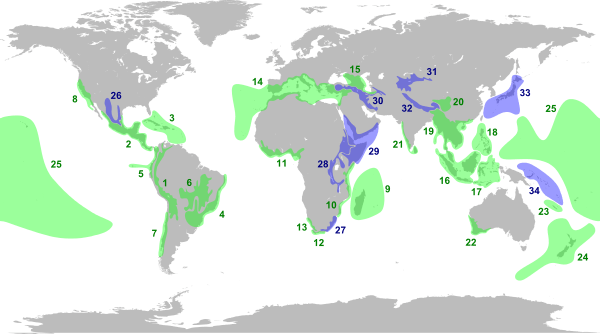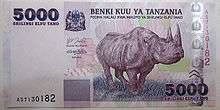Flagship species







The concept of flagship species has its genesis in the field of conservation biology. The flagship species concept holds that by raising the profile of a particular species, it can successfully leverage more support for biodiversity conservation at large in a particular context.[1]
Definitions
Several definitions have been advanced for the flagship species concept and for some time been there has been confusion even in the academic literature.[2] Most of the latest definitions focus on the strategic and socio-economical character of the concept, with a recent publication establishing a clear link with the marketing field.[2]
- “a species used as the focus of a broader conservation marketing campaign based on its possession of one or more traits that appeal to the target audience.”[2]
- species that have the ability to capture the imagination of the public and induce people to support conservation action and/or to donate funds[3]
- popular, charismatic species that serve as symbols and rallying points to stimulate conservation awareness and action[4]
The term flagship is linked to the metaphor of representation. In its popular usage, flagships are viewed as ambassadors or icons for a conservation project or movement.[5]
However, more recently, work in the field of microbiology[6][7] has started to use the concept of flagship species in a distinct way. This work relates to the biogeography of micro-organisms and uses particular species because "eyecatching “flagships” with conspicuous size and/or morphology are the best distribution indicators".[6]
Examples
Examples of flagship species include the Bengal tiger (Panthera tigris), the giant panda (Ailuropoda melanoleuca), the Golden lion tamarin (Leontopithecus rosalia), the African elephant (Loxodonta sp.) and Asian elephant (Elephas maximus).[2][8]
Flagship species can represent an environmental feature (e.g. a species or ecosystem), cause (e.g. climate change or ocean acidification), organization (e.g. NGO or government department) or geographic region (e.g. state or protected area).[2][9][10]
History
The flagship species concept appears to have become popular around the mid 1980s[11] within the debate on how to prioritise species for conservation. The first widely available references to use the flagship concept applied it to both neotropical primates[12] and African elephants and rhinos,[13] in the typical mammal centric approach that still dominates how the concept is used today[8][10][14]
The use of the concept has been largely dominated by large bodied species,[15] especially mammals,[14] although species from other taxonomic groups have occasionally been used[16]
Selection
Flagship species can be selected according to many different characteristics depending on what is valued by the audience they try to target.[2][10] This is best illustrated by the differences in recommendations made for flagship species selection targeting different target audiences such as local communities.[17] and tourists.[15]
Limitations
Several limitations have been recognized concerning the use of flagship species:[1]
- The use of flagship species can skew the management and conservation priorities in their favour and to the detriment of more threatened species[18]
- The managements of different flagships can conflict[18]
- The disappearance of the flagship can have negative impacts on the attitudes of the conservation stakeholders[18]
Flagships and conflict
A major challenge for the deployment of several flagship species in non-Western contexts is that they may come into conflict with local communities, thereby jeopardizing well-intended conservation actions. This has been termed 'flagship mutiny' and is exemplified by the Asian elephant in countries where there is human-elephant conflict.[8]
Other types of conservation flagships
Conservation flagships can also appear at broader levels, for example as ecosystems (such as coral reefs or rainforests or protected areas (Serengeti or Yellowstone).[2] A number of recent initiatives has developed new conservation flagships based on conservation values of particular areas or species. Examples of these are the EDGE project run by the Zoological Society of London and the Hotspots run by Conservation International.[2]
See also
References
- 1 2 Ducarme, Frédéric; Luque, Gloria M.; Courchamp, Franck (2013). "What are "charismatic species" for conservation biologists ?" (PDF). BioSciences Master Reviews. 1. Retrieved 19 December 2013.
- 1 2 3 4 5 6 7 8 Veríssimo, D., D. C. MacMillan, and R. J. Smith. 2011. Toward a systematic approach for identifying conservation flagships. Conservation Letters 4:1-8.
- ↑ Walpole, M.J., Leader-Williams N. (2002) Tourism and flagship species in conservation. Biodiversity Conservation 11, 543–547.(Walpole & Leader-Williams 2002)
- ↑ Heywood, V.H. (1995) Global biodiversity assessment. Cambridge University Press, Cambridge.
- ↑ Barua, M. 2011. Mobilizing metaphors: the popular use of keystone, flagship and umbrella species concepts. Biodiversity and Conservation, 20: 1427-1440.
- 1 2 Foissner, W. 2005. Two new "flagship" ciliates (Protozoa, Ciliophora) from Venezuela: Sleighophrys pustulata and Luporinophrys micelae. European Journal of Protistology, 41, 99-117.
- ↑ Foissner, W.; Stoeck, T. (2006), "Rigidothrix goiseri nov gen., nov spec. (Rigidotrichidae nov fam.), a new "flagship" ciliate from the Niger floodplain breaks the flexibility-dogma in the classification of stichotrichine spirotrichs (Ciliophora, Spirotrichea)", European Journal of Protistology, 42: 249–267, doi:10.1016/j.ejop.2006.07.003
- 1 2 3 Barua, M., J. Tamuly, and R.A.Ahmed. 2010. Mutiny or clear sailing: examining the role of the Asian elephant as a flagship species. Human Dimensions of Wildlife 15(2):145-160.
- ↑ Veríssimo, D., D. C. MacMillan, and R. J. Smith. 2011. Marketing diversity: a response to Joseph and colleagues. Conservation Letters 4:326-327.
- 1 2 3 Barua, M., M. Root-Bernstein, R.J. Ladle and P. Jepson. 2010. Defining flagship uses is critical for flagship selection: a critique of the IUCN climate change flagship fleet. Ambio, 40: 431-435.
- ↑ Frazier, J. 2005. Marine turtles: the role of flagship species in interactions between people and the Sea MAST, 3(2) and 4(1),5–38
- ↑ Mittermeier, R. 1988. Primate diversity and the tropical forest. Pages 145-154 in E. O. Wilson, editor. Biodiversity. National Academy Press. , Washington, DC.
- ↑ Mittermeier, R. A. 1986. Primate conservation priorities in the Neotropical region. Pages 221-240 in K. Benirschke, editor. Primates: The road to self-sustaining populations. . Springer- Verlag, New York
- 1 2 Leader-Williams, N., and H. T. Dublin. 2000. Charismatic megafauna as ‘flagship species’. Pages 53–81 in A. Entwistle, and N. Dunstone, editors. Priorities for the Conservation of Mammalian Diversity: Has the Panda Had Its Day. Cambridge University Press
- 1 2 Veríssimo, D., I. Fraser, R. Bristol., J. Groombridge, and D. MacMillan. 2009. Birds as tourism flagship species: A Case Study on Tropical Islands. Animal Conservation 12:549-558.
- ↑ Guiney, M.S., Oberhauser K.S. (2008) Insects as flagship conservation species. Terr Arthropod Rev 1, 111–123.
- ↑ Bowen-Jones E., Entwistle A. (2002) Identifying appropriate flagship species: the importance of culture and local contexts. Oryx 36, 189-195.
- 1 2 3 Simberloff D. (1998) Flagships, umbrellas, and keystones: Is single-species management passe in the landscape era? Biological Conservation 83, 247-257.
Further reading
- Veríssimo, D., Jones, D., Chaverri, R., and Meyer, S.R. (2012) Jaguar Predation of Marine Turtles: Conflict among Flagship Species in Tortuguero, Costa Rica. Oryx
- Veríssimo, D., D. C. MacMillan, and R. J. Smith. 2011. Toward a systematic approach for identifying conservation flagships. Conservation Letters 4:1-8.
- Takahashi, Y., D. Veríssimo, D. C. MacMillan, and A. Godbole. 2012. Stakeholder Perceptions of Potential Flagship Species for the Sacred Groves of the North Western Ghats, India. Human Dimensions of Wildlife 17:257-269.
- Veríssimo, D., M. Barua, P. Jepson, D. C. MacMillan, and R. J. Smith (2012) Selecting marine invertebrate flagship species: Widening the net. Biological Conservation 145(1), 4
- Smith, R. J., Veríssimo, D., Isaac, N. J.B. and Jones, K. E. (2012), IdentifyingCinderella species: uncovering mammals with conservation flagship appeal
- Barua M., Root-Bernstein M., Ladle R.J., Jepson P. (2011) Defining Flagship Uses is Critical for Flagship Selection: A Critique of the IUCN Climate Change Flagship Fleet. Ambio 40, 431-435.
- Barua, M., J. Tamuly, and R.A. Ahmed. (2010) Mutiny or Clear Sailing? Examining the Role of the Asian Elephant as a Flagship Species. Human Dimensions of Wildlife, 15(2): 145-160.
- Barua, M. (2011) Mobilizing metaphors: the popular use of keystone, flagship and umbrella species concepts. Biodiversity and Conservation, 20: 1427-1440.
- D.Verissimo , Fraser I., Bristol. R., Groombridge J., MacMillan D. (2009) Birds as tourism flagship species: a case study on tropical islands. Anim Conserv 12, 549–558.
- Caro T. (2010) Conservation by proxy. Island Press, Washington DC.
- Home R., Keller C., Nagel P., Bauer N., Hunziker M. (2009) Selection criteria for flagship species by conservation organizations. Environmental Conservation 36, 139-148.
